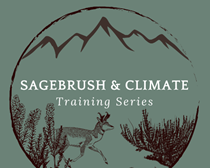Sagebrush
View synthesis.
This review revealed tradeoffs in woody fuel treatments between reducing canopy fuels vs. increasing understory herbaceous vegetation (fuels) and fire behavior. In pinyon-juniper expansion areas, all treatments decreased crown fire risk. Prescribed fire and cut and broadcast burn treatments reduced woody fuels long-term but had higher risk of invasion. Mechanical treatments left understory vegetation intact and increased native perennial plants. However, cut and leave treatments increased downed woody fuel and high-intensity wildfire risk, while cut and pile burn and mastication caused localized disturbances and annual grass invasion. Ecological outcomes depended on ecological resilience; sites with warm and dry conditions or depleted perennial native herbaceous species experienced lower recovery and resistance to invasive annual grasses. In invasive annual grass dominated areas, high-intensity targeted grazing reduced fine fuels but required retreatment or seeding; in intact ecosystems with relatively low shrub cover, dormant season targeted grazing reduced fine fuel and thus fire spread. Preemergent herbicides reduced annual grasses with differing effects in warm and dry vs. cool and moist environments.
Instructor: Arnold (Jerry) Tiehm, Great Basin Flora Specialist, [email protected]
Description: This three-day short course covers the unique taxonomy associated with the sunflower Family, Asteraceae. Basic terminology, dissection skills, and use of a key are critical elements of this class. The course will cover not only how to identify sunflowers, but how to collect and press them for future reference or for the purpose of mailing to others for identification or verification. You can anticipate seeing about 60 different genera. This class is for participants with beginner through intermediate skills.
This class may be taken for 1 unit of optional credit during either semester. Let the instructor know if you want to receive credit so you can obtain a class number. You must also pay the separate credit fees with UNR.
Class size is limited to 30 participants.
When: July 8-10, 2024. Class will be from 8:00 am -12:00 pm, one hour lunch break, 1 pm – 5 pm daily.
Where: It will be held in room 300G of Fleischman Agriculture at UNR. Hot water and some coffee and tea will be provided.
Cost: $ 240.00 non-student, $ 120.00 student. Plan on bringing a check to class made out to Board of Regents.
Sign up by emailing the instructor at [email protected].
Webinar recording.
Feb 29 2024 Missoula Fire Lab Seminar Series Presenter: Karen Short, RMRS Research Ecologist.
Training webpage.
North American sagebrush ecosystems are a regional priority of the U.S. Fish and Wildlife Service (FWS). The FWS Science Applications Program is working in partnership with multiple USGS Climate Adaptation Science Centers (CASCs), including the South Central CASC, Northwest CASC, North Central CASC, and Southwest CASC, and Boise State University, to develop a training series for sagebrush conservation practitioners. These trainings will begin in February 2024 with a self-paced introductory course, a series of virtual classrooms, and an in-person workshop in May 2024.
Webinar recording.
Webinar sessions will be half presentation and half question and answer. All presenters are scientists at the Rocky Mountain Research Station.
View article.
Biodiversity is threatened due to land-use change, overexploitation, pollution, and anthropogenic climate change, altering ecosystem functioning around the globe. Protecting areas rich in biodiversity is often difficult without fully understanding and mapping species’ ecological niche requirements. As a result, the umbrella species concept is often applied, whereby conservation of a surrogate species is used to indirectly protect species that occupy similar ecological communities. One such species is the greater sage-grouse (Centrocercus urophasianus), which has been used as an umbrella to conserve other species within the sagebrush (Artemisia spp.) ecosystem. Sagebrush-steppe ecosystems within the United States have experienced drastic loss, fragmentation, and degradation of remaining habitat, threatening sagebrush-dependent fauna, resulting in west-wide conservation efforts to protect sage-grouse habitats, and presumably other sagebrush wildlife. We evaluated the effectiveness of the greater sage-grouse umbrella to conserve biodiversity using data-driven spatial occupancy and abundance models for seven sagebrush-dependent (obligate or associated) species across the greater Wyoming Basins Ecoregional Assessment (WBEA) area (345,300 km2) and assessed overlap with predicted sage-grouse occurrence. Predicted sage-grouse habitat from empirical models only partially (39–58%) captured habitats identified by predicted occurrence models for three sagebrush-obligate songbirds and 60% of biodiversity hotspots (richness of 4–6 species). Sage-grouse priority areas for conservation only captured 59% of model-predicted sage-grouse habitat, and only slightly fewer (56%) biodiversity hotspots. We suggest that the greater sage-grouse habitats may be partially effective as an umbrella for the conservation of sagebrush-dependent species within the sagebrush biome, and management actions aiming to conserve biodiversity should directly consider the explicit mapping of resource requirements for other taxonomic groups.
View article.
Large-scale disturbances, such as megafires, motivate restoration at equally large extents. Measuring the survival and growth of individual plants plays a key role in current efforts to monitor restoration success. However, the scale of modern restoration (e.g., >10,000 ha) challenges measurements of demographic rates with field data. In this study, we demonstrate how unoccupied aerial system (UAS) flights can provide an efficient solution to the tradeoff of precision and spatial extent in detecting demographic rates from the air. We flew two, sequential UAS flights at two sagebrush (Artemisia tridentata) common gardens to measure the survival and growth of individual plants. The accuracy of Bayesian-optimized segmentation of individual shrub canopies was high (73–95%, depending on the year and site), and remotely sensed survival estimates were within 10% of ground-truthed survival censuses. Stand age structure affected remotely sensed estimates of growth; growth was overestimated relative to field-based estimates by 57% in the first garden with older stands, but agreement was high in the second garden with younger stands. Further, younger stands (similar to those just after disturbance) with shorter, smaller plants were sometimes confused with other shrub species and bunchgrasses, demonstrating a need for integrating spectral classification approaches that are increasingly available on affordable UAS platforms. The older stand had several merged canopies, which led to an underestimation of abundance but did not bias remotely sensed survival estimates. Advances in segmentation and UAS structure from motion photogrammetry will enable demographic rate measurements at management-relevant extents.
View article.
Sagebrush steppe is one of the most threatened ecosystems in North America. Adult density of songbirds within sagebrush steppe is a metric used to evaluate conservation actions. However, relying on only adult density to guide conservation may be misleading. Information on how conservation actions influence the nest density and nest survival of songbird species, in addition to adult density, are needed. We evaluated the relationships between nest density, nest survival, and adult density of Brewer’s sparrow (Spizella breweri) and vesper sparrow (Pooecetes gramineus) over 3 breeding seasons in central Montana. Our findings suggest that adult pairs of both species were often present in higher numbers than nests, and this relationship was most prominent for Brewer’s sparrows. However, our results do not support density dependence when considering nest survival. This discrepancy suggests that songbirds may not breed every year and that density dependence may be operating on nest densities within these populations differently than we examined. This study provides information on relationships between population demographics for 2 songbird species in grazed sagebrush steppe that will improve monitoring and management activities of conservation efforts.
View article.
Restoration of the foundational species, big sagebrush (Artemisia tridentata Nutt.), of the sagebrush steppe biome has not kept pace with the loss of habitat, demanding new tools to improve its restoration. Seed enhancement technology (SET) is one approach that is increasingly being tested in native plant restoration as a means to overcome establishment barriers. Like many semiarid shrubs, sagebrush faces establishment barriers from inadequate moisture, competition from faster-growing grasses, and limited available nutrients. We performed a series of laboratory trials testing whether nutrient amendments could be applied to sagebrush seed using a SET to increase root length and biomass, thereby potentially increasing seedling survival. We initially tested 11 amendments applied directly to bare seeds; of these, a high-phosphorus fertilizer resulted in a 2.7x increase in root biomass and 71-mm increase in root length over the control. We then tested incorporating this fertilizer at multiple concentrations into a pellet SET and a ground dust. Although the fertilizer, particularly at higher concentrations, conferred some enhancement to seedling biomass, the pellet treatments had substantially lower emergence and survival than bare seed and dust treatments. These results indicate the potential for a “root-enhancement” SET to benefit sagebrush and other species like it; they also illustrate some of the challenges of SET development for native species. Sagebrush has small seeds that typically need light to germinate. Further work is needed to develop an appropriate technology that does not negatively impact emergence but still provides enough nutrients for enhanced root growth. Field testing is also needed to determine if increases in root growth translate into greater survival. Given the low success rate of sagebrush seeding in restoration projects, however, we suggest that it is worth considering root-enhancement SET alongside other efforts to improve sagebrush establishment success.
View article.
Biocrusts are sensitive to changes in livestock grazing intensity in arid rangelands and may be useful indicators of ecosystem functions, particularly soil properties like soil stability, which may suggest the potential for soil erosion. We compared biocrust community composition and surface soil stability in a big sagebrush steppe rangeland in the northwestern Great Basin in several paired sites, with or without long-term cattle grazing exclusion, and similar soils (mostly sandy loams), climate, and vegetation composition. We found that livestock grazing was associated with both lower surface soil stability and cover of several biocrust morphogroups, especially lichens, compared with sites with long-term livestock exclusion. Surface soil stability did not modify the effects of grazing on most biocrust components via interactive effects. Livestock grazing effects on total biocrust cover were partially mediated by changes in surface soil stability. Though lichens were more sensitive to grazing disturbance, our results suggest that moss (mostly Tortula ruralis in this site) might be a more readily observable indicator of grazing-related soil stability change in this area due to their relatively higher abundance compared with lichens (moss: mean, 8.5% cover, maximum, 96.1%, lichens: mean, 1.0% cover, maximum, 14.1%). These results highlight the potential for biocrust components as sensitive indicators of change in soil-related ecosystem functions in sagebrush steppe rangelands. However, further research is needed to identify relevant indicator groups across the wide range of biocrust community composition associated with site environmental characteristics, variable grazing systems, other rangeland health metrics, and other disturbance types such as wildfire.






